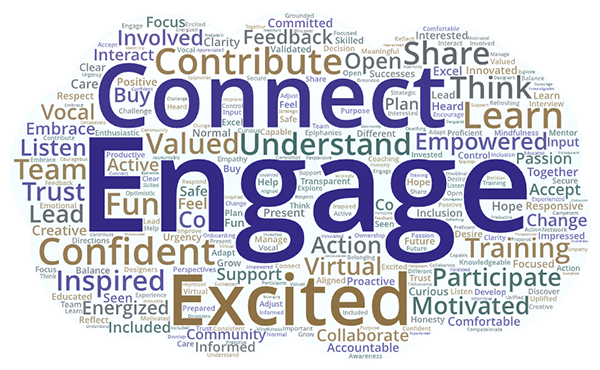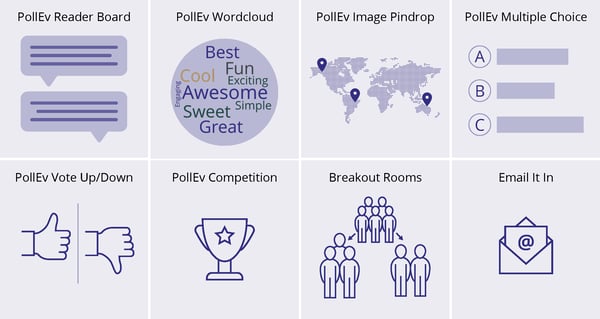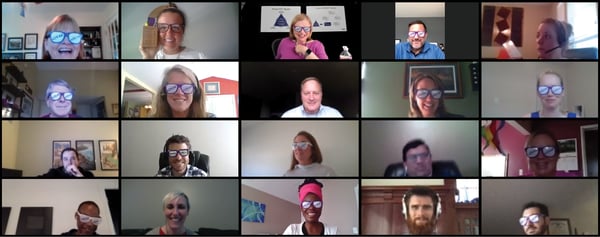5 Tips for Creating Captivating Virtual Engagements

4 Mins
Updated: November 10, 2022
Published: June 17, 2020

The involuntary digital transformation we are experiencing today has created chaos and opportunity for organizations. As an organization that only delivered in-person services on March 1, 2020, Prosci had to pivot to virtual offerings within weeks to deliver on our client commitments and meet new demands. We learned that delivering virtual engagements is far more complex than it seems, but we also discovered unique opportunities to engage and bring humanity into the experiences we create for our clients.
Delivering high-quality, transformational experiences is core to our business, so we knew that creating impactful virtual offerings would be critical. But even if your business model hasn’t changed, much of the work of change management professionals must now be done virtually. Team meetings, one-on-one coaching, project kickoffs, working sessions, workshops and training, ideation and brainstorming, impact assessments and more all require digital approaches.
Engaging With People Virtually
How can you create captivating virtual experiences that keep your people engaged? Here are five key lessons learned from our experience:
1. Pivot around purpose
In the face of crisis, we generally have two options: chaotically flailing or pivoting. The difference is knowing who you are and being grounded in your purpose, whether as an individual, a team, a discipline, a practice or an organization. This even applies if you’re trying to make an event more captivating because now it must be virtual.
To pivot, we must anchor to purpose. When the pandemic led Prosci to pivot to virtual offerings, we knew who we were. We started with the purpose of our programs, which was to create a transformational experience that empowers and emboldens change agents to drive adoption and usage, and tackle the challenges of change in a new way. That was the purpose of the Prosci Change Management Certification experience, and we protected that purpose at all costs.
As you are thinking about that one-on-one coaching, ideation session, meeting, or project team kickoff, ask yourself: What is the purpose of this virtual event? Who is your audience? What do you want them to think, feel or do differently as a result of the virtual engagement?

2. Create a virtual engagement language
Any time we interact with someone, we need pathways to exchange ideas and information. That's what language is. Virtual engagement needs these pathways too.
When it came to our virtual training, one of our first steps was to create a fit-for-purpose toolbox—our virtual engagement language. Instead of just leveraging any tool for any use, we identified and pulled forward the specific functionalities and interaction techniques at specific points in the experience. We leveraged chat, annotation and polling to amplify the pathways—the virtual engagement language—to interact.

3. Master virtual facilitation
As we created our transformational virtual experiences, Prosci instructors needed to shift their mindset from being an instructor to being a host. How do you manage time? How do you engage participants? How do you make sure you’re organized for a virtual environment? How do you adapt your own stories and engagement techniques?
Facilitating virtually is a different experience that requires far more preparation and intentionality. Because you lose some of the flexibility you had when you occupied the same room with people, you must be mindful of the issues that arise and how you will address them.
Technology can be your friend or foe. Technology can be your foe if you're not comfortable with the virtual platform, haven’t figured out all of the idiosyncrasies, haven’t assembled your backup plan, or don't know what you're going to do if things do go sideways. It’s your job to make it a friend, to be so comfortable stepping into it that it’s second nature and you can focus on engaging your people.
When you’re delivering a virtual engagement, you want to look like a duck swimming across water: calm above and paddling like crazy below. At Prosci, we accomplish this in part through the role of the producer. They’re content experts, technology maestros, and relationship gurus who answer questions as they come in, troubleshoot issues, and manage relationships with program attendees in real time. The host and producer team contribute to the magic of the virtual facilitation.
4. Avoid boredom and distraction
In a virtual engagement, boredom and distraction are your biggest enemies. We established a rule of thumb that we try to follow in all virtual settings: the learner needs to do something other than listening and watching every five to six minutes. While we may not adhere to it all the time, it’s something we strive for to avoid long listening spells.
We also have a “cameras on” rule for virtual programs. This may not be effective for large-scale events, but for workshops, training programs, even internal team meetings, cameras create visual connection and are essential for virtual engagement.
People need breaks, especially in virtual sessions. We use a 50/10 or 60/15 model, being sure to take a 10-minute break every 50 minutes or a 15-minute break every hour. Boredom and distraction start setting in heavily at the end of a segment, so we also include energizers—small, spontaneous or planned events designed to re-engage and re-energize the group, especially when we return from breaks.
On one of my programs, we held a crazy hat contest during a virtual session of our Integrating Agile and Change Management Workshop. We had attendees come back at the end of the break wearing their craziest hats. The gentlemen who won was wearing a unicorn horn with a veil that his 7-year-old daughter helped him get just right. The extra 5 minutes we spent in this unique engagement brought humanity and energy right back into the program. It was magical.
5. Embrace what is uniquely virtual
We’re going to be virtual for some time, or at least hybrid, as we return the workplace, so it’s important to embrace it. What can you do in this virtual environment that you couldn’t have done otherwise, and how will you amplify those actions?
I’d like to share one quick example. I’ve been doing cameo visits for nearly all of our programs. One Thursday, I dropped in on 11 certification programs in a single day, engaging with change agents on six continents, which is something I can only do when I’m a click away instead of a flight away.
Virtual platforms can also help us level the playing field for introvert learners because people often communicate, ask questions, or contribute ideas at the same time and in multiple ways. That is wonderfully unique in a virtual environment. If you are thoughtful about bringing forward those opportunities, you can amplify the experience and engagement for all types of people.

The Virtual World is Here to Stay
Many CIOs and CTOs were trying to execute digital transformations when we all got the “involuntary” version courtesy of the COVID-19 pandemic. Moving to a node-to-node, virtual world has unexpectedly and paradoxically breathed humanity into the connective tissue that makes up our networks and organizations. Our pets, our children, and our partners are no longer faceless because much of our work moved to home offices, living rooms and kitchen tables. That's a level of connection we didn’t have when we were physically together. Let’s embrace that newfound humanity like crazy as we navigate the hybrid virtual world and re-imagine how work and change happen in our organizations. The ripples of the involuntary digital transformation will last longer than the pandemic, so we will need to focus on creating captivating experiences if we want to succeed in our virtual world.


